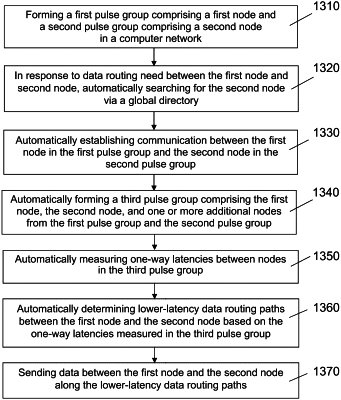| CPC H04L 45/70 (2013.01) [H04L 43/0858 (2013.01); H04L 45/04 (2013.01)] | 22 Claims |

|
1. A method for autonomously selecting low-latency data routing paths across the Internet by a distributed system, comprising:
forming, in a computer network, a first pulse group comprising a plurality of nodes including a first node and a second pulse group comprising a plurality of nodes including a second node, wherein one-way latencies are automatically measured between nodes in the first pulse group, wherein one-way latencies are automatically measured between nodes in the second pulse group;
in response to a data transfer need between the first node and the second node, automatically forming a third pulse group comprising the first node, the second node, and at least one additional node from the first pulse group or the second pulse group;
automatically measuring one-way latencies between nodes in the third pulse group, including a first one-way latency for a direct path from the first node to the second node;
automatically determining a first lower-latency data routing path from the first node to the second node based on the one-way latencies in the third pulse group, wherein the first lower-latency data routing path passes through a first relay node in the third pulse group, wherein the first lower-latency data routing path has a sum of one-way latencies from the first node to the second node via the first relay node lower than the first one-way latency; and
sending data from the first node to the second node along the first lower-latency data routing path via the first relay node.
|